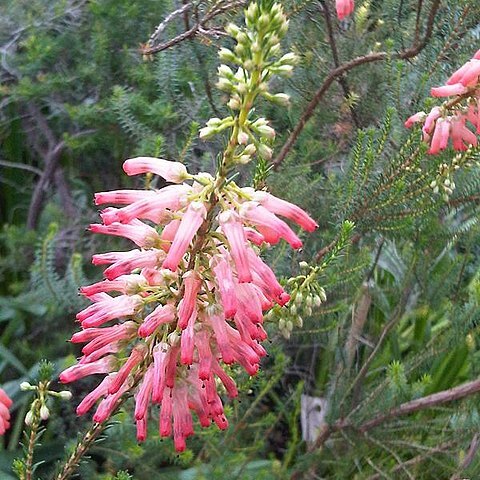Erect, 4-12 ft. high, greyish in all parts; branches virgate or spreading, pubescent; leaves 3-nate, suberect to squarrose, usually spreading, linear to linear-lanceolate, acute, open-backed, greyish-pubescent, occasionally subglabrous, commonly 4-6 (sometimes 7) lin. long; flowers 3-nate or umbellate; pedicels tomentose, about 2 lin. long; bracts remote, minute, adpressed; sepals lanceolate, acuminate, margin reflexed at the apex, pubescent, 1-2 1/2 lin. long; corolla long-persistent, ovoid-tubular-urceolate, throat contracted, laxly villous, or rarely finely pubescent, most usually white or yellowish-white, 2 1/2-3 1/2 lin. long; segments very small, spreading; filaments broader at the base, tapering upwards; anthers included, oblong, somewhat wider at the base, pallid, under 1/2 lin. long, aristate; awns subulate, about 1/2 as long as the cell; style just exserted; ovary shortly villous or strigose.
Erect shrub or small tree, 1.3-4.0 m high, greyish in all parts. Leaves 3-nate, suberect to squarrose, spreading, 8.4-12.6(-14.7) mm long, linear-lanceolate, acute, open-backed. Flowers 3-nate or umbellate. Calyx sepals 2.1-5.3 mm long, lanceolate, acuminate, margins reflexed at apex, pubescent. Corolla long-persistent, 5.2-7.4 mm long, ovoid-tubular-urceolate or conical, throat contracted, laxly villous, white or yellowish white; lobes small, spreading. Filaments broad at base; anthers included, up to 1 mm long, oblong, pallid, aristate; appendages ± 1/2 as long as theca, subulate. Ovary shortly villous; style just exserted. Flowering time July-Dec.
Erect shrub or small tree to 4 m. Flowers medium, conical, white, finely hairy.


